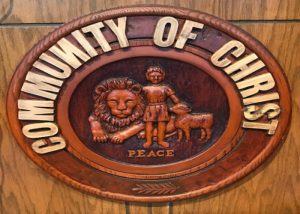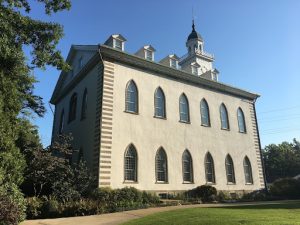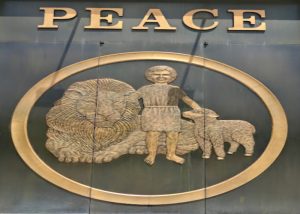If you walk up to a structure owned by Community of Christ, somewhere on the inside or outside of the building, you will usually see the seal of the church. This prominent symbol of the faith features a lion, a lamb, and a little child, referencing the words of Isaiah that the lion and the lamb would lie down together “and a little child shall lead them.” Usually emblazoned somewhere on the seal is the word “peace.” Created 150 years ago this April, it began to be used on books, stationary, and in and on buildings after World War I by the Reorganized Church of Jesus Christ of Latter Day Saints, today called Community of Christ. The symbolism of the seal goes all the way back to the dedication of the Kirtland Temple, where the early saints sang “The Spirit of God,” which expresses a longing for “the day when the lamb and lion shall lie down together without any ire.” This seal/logo has become the most consistent symbol of the values of the church.

Last week, Community of Christ demonstrated its commitment to peace. On Tuesday, March 5, a joint statement from leaders of Community of Christ and The Church of Jesus Christ of Latter-day Saints announced the sale of a number of historic sites and artifacts—most notably the House of the Lord in Kirtland, Ohio. An official set of questions and answers listed the price of the sale as $192.5 million, but this was not the most notable aspect of the arrangement. What truly made this transfer remarkable is that it took place peacefully. Sacred property and objects were exchanged with no spilling of blood and no acts of violence. In the history of religions, this is a rare occurrence. One need only think of the history of the tragic conflict in the Holy Land, which continues up to this very moment, to see where other religious disagreements can lead. In a world marred with blood and conflict over religion, the Kirtland Temple transfer is truly remarkable.
Why was such a peaceful transfer possible? Much of the credit goes to the emphasis on peace taught by Community of Christ throughout its history. One of the most formative and beloved figures in the history of Community of Christ is Joseph Smith III, son of Joseph Smith, Jr., founding prophet of the Latter-day Saint movement. Joseph III, as he is usually referred to by church members, grew up in a world surrounded by violence. When he was just six years old, he witnessed his father dragged away from his family. Young Joseph desperately held onto his father’s leg, crying, “My father, my father, why can’t you stay with us? O, my father, what are the men going to do with you?” According to one witness, the guards responded to the little by saying, “You damned little brat, go back; you will see your father no more.” Only six years later, Joseph III saw the bodies of his father and his uncle, Hyrum Smith, brought back in a wagon after their murder in Carthage Jail.
These scenes made a deep impression on Joseph III. Later, as a grown man, he accepted leadership over a collection of Latter-day Saint movements that united to form the Reorganized Church. As a leader over the church, two words described Joseph III’s administrative style: pragmatism and peace. Presiding over a diverse coalition with a number of strong leaders, Joseph III used his pragmatic nature to calm dissent, bring compromise, and create a cohesive movement. It was no simple task, and the fingerprints of Joseph III’s leadership are still evident in the way the church is run. When I attended their World Conference a few years ago, I was struck by the respect and adherence to parliamentary procedures. Everyone seemed to know by heart Robert’s Rules of Order, a 19th-century handbook on parliamentary procedure that was last updated in 2015. It was necessary for the movement to survive as it built consensus among the disparate branches coming together to form the reorganized church. A member of the church once expressed his admiration for Joseph III’s leadership by saying, “I think Brigham got all the dogs, and Joseph III got all the cats, but somehow he made it work.”
The second hallmark of Joseph III’s leadership was his emphasis on peace. An 1873 revelation given to Joseph III taught, “Let contentions and quarrelings among you cease. Sustain each other in peace, and ye shall be blessed with my Spirit, in comforting and strengthening you for my work.” Having seen the horrors of violence in his youth, Joseph III constantly pled for peace. Under his leadership, the peace seal was adopted as a symbol of the church, and then after World War I grew in prominence. Joseph III served as church president from 1860 until his death in 1914. Part of his service overlapped with the tenure of his first cousin, Joseph F. Smith, Hyrum’s son, who presided over The Church of Jesus Christ of Latter-day Saints from 1901 to 1918. The two cousins even hosted each other several times during their lives. They had sharp disagreements on a number of topics, but that never overwhelmed the familial bond between them.

Community of Christ is led today by the spiritual descendants of Joseph Smith III. For the past eight years, I have had the privilege of meeting with a number of leaders and scholars from Community of Christ twice a year for interfaith dialogue. The meetings have hosted a number of fruitful discussions on topics ranging from Jesus Christ to sacraments and ordinances, to scripture, to personhood, and a host of other topics. There have been sharp disagreements at times, though the meetings have always been peaceful and possessed a unique spirit of fellowship. I must admit that as a fiery new religion professor I initially entered into these discussions with the aim to defend the faith. I still love to defend my beliefs, but I also learned to listen, to love, and to learn about and celebrate the wonderful good accomplished by members of both faiths.
These meetings have also taken place in a number of sacred spaces. One of our most memorable dialogues took place in the Kirtland Temple, where we met on the top floor where Joseph Smith saw a vision of the Celestial Kingdom. Earlier that day, our friends from Community of Christ allowed us the sacred privilege of kneeling down to offer our own prayers in the Melchizedek Priesthood pulpits where the resurrected Christ, along with the ancient prophets Moses, Elias, and Elijah appeared. On another occasion, our friends from Community of Christ joined us in Utah. They toured through the Jordan River Temple open house. The event organizers even permitted us to use an endowment room for our discussions, and we talked about the different perceptions of temple worship in a sacred space.
When I heard about the sale of the historic properties and artifacts on March 5, my first emotion was shock, then elation. I love these sacred spaces and objects. But shortly after, I began to receive messages from my friends in Community of Christ and other Restoration movements. The responses were quite different from mine, ranging from sadness to anger, to devastation, to pragmatic acceptance. I began to realize what a difficult day this was for many of the people that I care about. My impulse to celebrate was replaced with an impulse to “mourn with those that mourn, and comfort those that stand in need of comfort.”
The reasons for the sale were pragmatic. A joint statement released by both churches announced that negotiations over the agreement began in the summer of 2021. Stephen M. Veazey, the president of Community of Christ, wrote, “This exchange of assets is significant for our church. Through funding from increased endowments, Community of Christ will have greater capacity to pursue our mission priorities around the world, including continuing to fulfill the divinely envisioned purposes for our Temple in Independence, Missouri.” Russell M. Nelson, president of The Church of Jesus Christ of Latter-day Saints, responded by saying, “We are deeply honored to assume the stewardship of these sacred places, documents, and artifacts. We thank our friends at Community of Christ for their great care and cooperation in preserving these historical treasures thus far. We are committed to doing the same.”
I sincerely hope we can resist the urge to see this agreement as a win or a loss for either church. For me the most remarkable part of the entire event is that a piece of sacred geography was transferred peacefully. Artifacts that members of both faiths believe were touched by divine power exchanged stewardship with no loss of life or even sharp words. There were and still are deep emotions on both sides. Lachlan Mackay, who is both an apostle in Community of Christ and a descendant of Joseph Smith, Jr. and Joseph Smith III, released a tender video message where he remarked, “The decision to part with these places has been devastating emotionally. There was a time when I thought it might break me. But if I inherited anything from Joseph Smith III, it’s his pragmatism, and intellectually, the path forward is clear. I care deeply about our past, but I care even more about our future.”

It is a historical oddity that descendants of Joseph Smith, Jr. became key leaders in Community of Christ and descendants of Hyrum Smith became key leaders in The Church of Jesus Christ of Latter-day Saints. Wallace B. Smith, a Joseph Smith descendant and former president of Community of Christ, passed away only this past September. M. Russell Ballard, a descendant of Hyrum Smith and an acting president of the Quorum of the Twelve Apostles of The Church of Jesus Christ of Latter-day Saints passed away just two months later. I can’t help but think that both Joseph and Hyrum would be pleased with the peaceful way this agreement has been carried out. I also imagine that Joseph III would feel sadness over the transfer of the historical properties but also a sense of pride in seeing his spiritual descendants still adhere to his values. His peaceful nature and his pragmatism still guide the movement he loved.
I can also hope that the exemplar of both churches, the Teacher who declared “blessed are the peacemakers, for they shall be called the children of God,” would be pleased to see a religious exchange carried out in a peaceful way.
The post The Most Important Lesson Learned from the Kirtland Temple Agreement appeared first on Public Square Magazine.
Continue reading at the original source →



